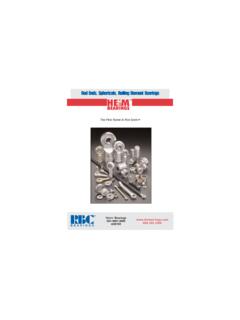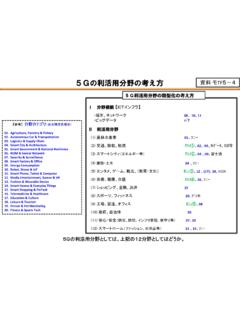Transcription of GEO 465/565 - Lectures 11 and 12 - Spatial Analysis
1 GEO 465/565 - Lectures 11 and 12 - " Spatial Analysis "(from Longley et al., GI Systems and Science, 2001) , Visualization and interactionA geographic information system provides a rich and flexible medium forvisualizing and interacting with geographic data. A GIS includes a variety offunctions for portraying attribute distributions and transforming Spatial can also interact with a GIS to turn raw data into information useful foranswering Spatial and temporal portraying information, attributes (or classes of attributes) can be displayedwith a variety of graphic symbols and used as labels to communicate , you can manipulate the shape of Spatial objects to the map on the left, the entire layer is symbolized with a single symbol. This is useful when youneed to differentiate one layer from another layer.
2 On the right, each feature is symbolized with adifferent color because the map designer wanted to make each feature distinguishable from theother features in the this map, each country is displayed with a different shade of darker the shade, the greater the country's , each country was placed into one of five groups based on its population. Each circlerepresents the country's population relative to the other What is Spatial Analysis ?Through Spatial Analysis you can interact with a GIS to answer questions,support decisions, and reveal patterns. Spatial Analysis is in many ways the cruxof a GIS, because it includes all of the transformations, manipulations, andmethods that can be applied to geographic data to turn them into methods of Spatial Analysis can be very sophisticated, they can also bevery simple.
3 The approach this course will take is to regard Spatial Analysis asspread out along a continuum of sophistication, ranging from the simplest typesthat occur very quickly and intuitively when the eye and brain look at a map, tothe types that require complex software and advanced mathematical are many ways of defining Spatial Analysis , but all in one way or anotherexpress the fundamental idea that information on locations is essential. Basically,think of Spatial Analysis as "a set of methods whose results change when thelocations of the objects being analyzed change."For example, calculating the average income for a group of people is not spatialanalysis because the result doesn't depend on the locations of the the center of the United States population, however, is spatialanalysis because the result depends directly on the locations of , Types of Spatial AnalysisTypes of Spatial Analysis vary from simple to sophisticated.
4 In this course, spatialanalysis will be divided into six categories: queries and reasoning,measurements, transformations, descriptive summaries, optimization, andhypothesis and reasoning are the most basic of Analysis operations, in which theGIS is used to answer simple questions posed by the user. No changes occur inthe database and no new data are are simple numerical values that describe aspects of geographicdata. They include measurement of simple properties of objects, such as length,area, or shape, and of the relationships between pairs of objects, such asdistance or are simple methods of Spatial Analysis that change data setsby combining them or comparing them to obtain new data sets and eventuallynew insights. Transformations use simple geometric, arithmetic, or logical rules,and they include operations that convert raster data to vector data or vice may also create fields from collections of objects or detect collections ofobjects in summaries attempt to capture the essence of a data set in one ortwo numbers.
5 They are the Spatial equivalent of the descriptive statisticscommonly used in statistical Analysis , including the mean and standard techniques are normative in nature, designed to select ideallocations for objects given certain well-defined criteria. They are widely used inmarket research, in the package delivery industry, and in a host of testing focuses on the process of reasoning from the results of alimited sample to make generalizations about an entire population. It allows us,for example, to determine whether a pattern of points could have arisen bychance based on the information from a sample. Hypothesis testing is the basisof inferential statistics and forms the core of statistical Analysis , but its use withspatial data can be District Video (5 minutes)Now let's examine three Spatial Analysis examples and explore the resultinginformation.
6 (1) Examine land use and flood zone using simple overlay Analysis - findresidential parcels that are inside a flood zone area. Applicable to Corvallis as weare right along the Willamette River (Dr. Wright's house was endangered by thebig flood of 1996)Insurance companies examine flood zone areas to locate buildings and otherassets susceptible to flood damage. Their predictions can be used to targetinsurance sales. Ideally, insurance companies would like to target individualswho perceive they are at risk to flooding, but in practice are unlikely to beflooded. This allows the insurance company to receive the premium but not payany course, this approach poses some issues of risk and ethics. Refer to Chapters17 - 19 in Longley et al. for a discussion of risk and ethics when practicing this exercise, you will focus on finding any residential areas within the data The map contains flood zone and land use layers.
7 Turn on theflood zone layer and notice that the flood zone affects many of the land a statistical summary table to report the amount of each land use typeinside the flood zone stats dialogueresultThe table should have four records, one for each land use type in the flood field contains statistical information about that land use type's presencewithin the flood land use types are in the flood zone?Vacant, Agriculture, Residential, and Open spaceWhich one has the greatest area in the flood zone?AgricultureWhich land use type is most likely to contain homes?ResidentialFind the locations of the residential areas within the flood zoneYou've identified that residential areas are located within the flood zone, but moredetailed Analysis is necessary to pinpoint the locations of those residential the more detailed Analysis , it is useful to create a diagram or flow chart ofthe layers and Analysis functions you will use.
8 For this Analysis you will follow thesteps shown in the flow chart , you will query the Land use layer to create a new layer that contains onlyresidential areas. You will then create another query to find the residential areaswithin the flood zone. The final results will be a new layer that you will call the Spatial Analyst menu in ArcGIS, one would choose Raster CalculatorYou would build an expression that queries the "Land use" layer for residentialareas. [Land use] == 3 Values of 1change layer properties to show residential onlyNext, you would query both the Flood zone and Residential layers. Thisoperation is often called an overlay. The resulting layer will contain the residentialand flood areas that overlap (or intersect) each Calculator - [Flood zone] & [Residential].areas that are residential and in flood zone (bad news) (Values of 1)change layer properties to show residential onlyThe resulting areas are the ones that an insurance company may want to targetto sell flood insurance.
9 City planners could also use this information for disasterplanning services.(2) Examine soil samples of a farm area using interpolationIn this step, you will help a farmer balance the pH levels in a field that is beingprepared for the next growing season. Some crops have better yields when thesoils have a balanced pH level. Seven is a balanced pH level. Areas in the fieldwith a pH less than seven are treated with lime (limestone) to raise the pH with a pH above seven are treated with ammonium sulfate to lower the farmer should not treat an entire field with all lime or all ammonium sulfate,but should locate areas of high and low pH and treat them accordingly (precisionfarming techniques). You will help the farmer find the areas that should betreated with ammonium sulfate (areas with pH greater than seven).
10 Look at data - soil samples in farm areaThis map contains two layers. The Soil samples layer represents the soilsamples that were collected in the field and tested for chemical composition. Itcontains several fields containing the chemical levels at each sample point. TheFarm field layer represents the extent of the farmer's this Analysis you will follow the steps shown in the flow chart will interpolate a surface of pH values from the samples. You will then querythe surface to find areas with pH greater than seven. The final results will be theareas the farmer needs to treat with ammonium up IDW dialogResulting interpolation is a "pH surface" - The dark green areas have low pHvalues, while the light pink areas have high pH areas of high pH. Next, you will isolate the high pH areas by creating alayer containing only areas with pH levels above Calculator - [pH surface] > 7, pH Treatment Areas.








